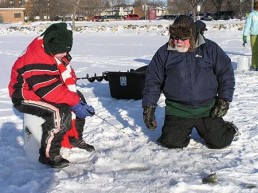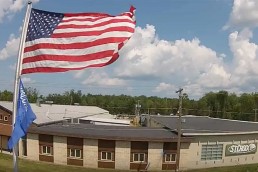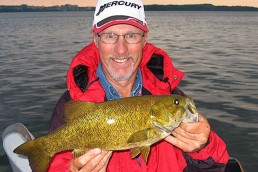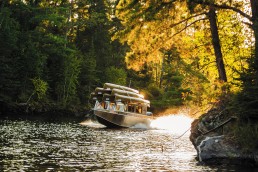The Best Waters for Winter Bluegills in Southern Wisconsin
The southern third of the state of Wisconsin has many lakes that have both good numbers and good-sized bluegills. The waters that I’m going to recommend are all within 50 to 60 miles of Madison, the state’s capital. The waters of the Madison Chain of Lakes all provide good bluegill action if you do a little research, talk to locals, or hire a guide. Though the lakes can be crowded on weekends, it’s still possible to get away from the crowds and find your own fish without other anglers drilling holes closer to you every time that you catch a fish.
First, we’ll start with the Madison Chain and head north from there. Here are some very good locations that will provide you with both action and some tasty ‘gills for the frying pan:
- Around downtown Madison, fish the “Triangle” area that is within walking distance of downtown Madison. The Triangle is near Brittingham Park and Monona Bay on Lake Monona. This is a good spot if you’re taking the children with and want “action” to keep them interested in fishing. You will have to sort through the many smaller fish to get your “keepers,” but it’s easy to find fish in this shallow and weedy bay. There are some eaters in the 7- to 8-inch range, but this is mainly a location for catching numbers and getting the youngsters interested in ice fishing. Children don’t seem to care what they’re catching as long as they have “something” pulling on their line. This is a good way to get the kids interested in ice fishing and the outdoors. Access is good and the walk is an easy one for both children and seniors too.
- Warner Bay on Lake Mendota’s northeast side is another quality spot during the winter. There’s a distinct break line and numerous green weeds in the wintertime. Green weeds are magnets for fish in the winter. It also is a good idea to out a few tip-ups because the bay has a good northern pike population with many fish over 30 inches. The minimum length is 40 inches, so this is definitely a trophy lake for pike.
- Lake Mendota, the largest lake in the Chain (almost 10,000 acres) is one of the best bluegill lakes that I know in southern Wisconsin. This is the last lake to freeze in the Chain because of its size and depth. But once it does freeze over, be ready for some slab bluegills. The last few winters, the bluegills started biting in University Bay by the middle of December and continued throughout the winter. This “bite” was no secret and I worry about all the big bluegills that were taken out of this lake the last few winters. The average bluegill was 8-9 inches with many fish pushing 10 inches and even longer. A 10-inch bluegill weighs almost a pound and that is a big bluegill! Though the limit is 25 fish, you don’t have to keep that many fish for a few great meals. Keep 10 or 12 fish and leave some for the next guy or for brood stock. The fish moved around the Bay some, but basically they stayed in the same place all winter.
- Lake Waubesa, south of Madison, also has good bluegill and panfishing at the north end and around Hog Island. There also is a good bite directly out from the Lake Farm boat landing in water 7 feet deep and shallower.
- Fish and Crystal lakes are about 30 miles north of Madison. They are a few miles from the small berg of Roxbury and about 5 miles from Sauk City. Bluegills can be caught throughout the winter if you keep moving and “popping” holes till you find the active fish. Fish Lake is weedy, but it contains many bluegills that readily bite. This is another “action” lake where you have to sort through your fish for a good meal. But, you will catch fish! Crystal Lake has larger fish with bluegills, crappies and perch. The deepest water is only 10 feet deep. A good location to start fishing is the east end where you’ll find many stumps and trees that hold fish most of the year. Again, keep moving around till you contact fish. Fish and Crystal lakes are only a half mile apart and both can be fished easily the same day.
- Gallus Slough is another top location north of Sauk City, about 7 miles and on the north end of Lake Wisconsin. The Slough requires a little walk to get to the ice. The slough is just north of Lake Wisconsin’s Moon Valley and off Highway 78 and 113. There’s parking along Highway 113 and then a 10-minute walk to the slough and water. You can see the Slough from the highway. The walk may scare away a few anglers if there’s snow on the ground, but the walk is well worth it! Gallus Slough is shallow with all its water less than 5 feet deep. The bluegills that you’ll catch are some of the larger panfish in the area and I’d put this location on my must fish list. Bluegills over 8 inches are the norm and there are some ‘gills over 9 inches.
- Devils Lake, south of Baraboo, though known for its trout, has a sizeable population of quality bluegills, crappies and rock bass. The best fishing spots are at the south and east end of the lake. There’s ample parking, but you do need a state park sticker to park and fish. You can buy daily and yearly stickers at the park’s office on the lake’s north end. There are bluegills, crappies and sunfish close to and in the abundant green weeds. I also suggest fishing near the creek mouth at the lake’s south end especially if the water is at a higher level because there are also big northern pike, so put out a tip-up or two for a bonus northern pike.
- The last locations that I’m recommending to you are the numerous sloughs and backwaters along the Wisconsin River from Sauk City to Spring Green. Highway 60 runs along this 12-mile stretch with many of the sloughs visible from the highway. Traveling west from Sauk City, the sloughs will be on your left where you’ll see the Wisconsin River backwaters. There’s been enough moisture this fall, so the backwaters should be full of water. Rainbow, Badger, Jones and Helena Sloughs can all be productive for winter bluegills, crappies and pike. Remember, to be extra careful because there is flowing water from the river in all of these locations.
You now have numerous good fishing locations for bluegills of all sizes in southern Wisconsin. Here are a few more tips for success:
1) Use a quality monofilament (Berkley Ice Line) in 2-pound-test for bluegills. The smaller diameter line really makes a difference for finicky fish.
2) Make sure that you are using a spring bobber to detect the slightest bite.
3) Have a good selection of jigs in all sizes and colors (Bait Rigs and Custom Jigs and Spins make great panfish gear). Change jigs and colors till you find what the fish want that day.
4) Try using some of the new plastics for bluegills. I know many good fishermen who use nothing but plastics with great success.
5) If using live bait, wax worms and spikes seem to work best.
6) Trust your electronics, especially if fishing in water deeper than 5 feet. The new color units (Lowrance) are great and easy to use.
7) Try drilling your holes before you start fishing, so that you don’t keep spooking fish. Keep moving and experimenting with your colors and jigging cadence till you find the biting and active fish.
For more information…
Contacts: Wilderness Fish and Game, Sauk City, Wis. 608-643-5229 and ask for Tom or Chuck.
McFarland’s True Value Hardware, Sauk City, Wis. 608-643-3321 and ask for Wayne.
Guides: Ron Barefield, 60-235-7685 or 608-838-8756 and Wally Banfi 608-644-9823.
MWO
SHARE THIS POST
Did you enjoy this post?
You can be among the first to get the latest info on where to go, what to use and how to use it!
Gary Engberg
If you have any questions or comments you may reach Gary Engberg at 608-795-4208 or garyengbergoutdoors.com.



